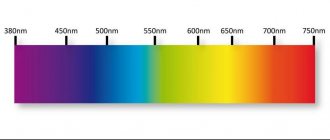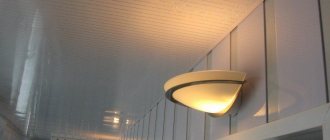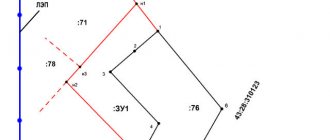Light on the electromagnetic scale Light.
The duality of the nature of light. Popular physics // capitanchocopie [16:00] Light
— electromagnetic waves of the visible spectrum. The visible range includes electromagnetic waves in the frequency range perceived by the human eye (7.5 × 10 14 - 4 × 10 14 Hz), that is, with a wavelength from 390 to 750 nanometers.
In physics, the term “light” has a slightly broader meaning and is synonymous with optical radiation, that is, it includes the infrared and ultraviolet regions of the spectrum.
The properties of light are studied by the branches of physics, optics and spectroscopy. Measuring light intensity is a field of photometry.
[edit] Physical nature and properties of light
Thanks to dispersion, white light can be separated into a spectrum using a prism.
Like any other electromagnetic waves, light is characterized by frequency, wavelength, polarization and intensity. In a vacuum, light propagates at a constant speed, independent of the reference frame - the speed of light. The speed of light propagation in a substance depends on the properties of the substance and is generally less than the speed of light in a vacuum. Wavelength is related to frequency by the law of dispersion, which also determines the speed of light propagation in the medium.
When interacting with matter, light is scattered and absorbed. When passing from one medium to another, the speed of propagation of light changes, which leads to refraction. Along with refraction, light is partially reflected at the boundary of two media. The refraction and reflection of light is used in various optical devices: prisms, lenses, mirrors, which allow the formation of an image.
The emission and absorption of light occurs by quanta: photons, the energy of which depends on frequency:
,
where E is the quantum energy, is the frequency, h is Planck’s constant.
Ordinary daylight consists of incoherent electromagnetic waves with a wide range of frequencies. This kind of light is usually called white. White light has a spectrum that matches that of the Sun. Light with a different spectrum is perceived as colored. Light dispersion allows light to be separated into colored components.
Like any other electromagnetic wave, light is characterized by polarization. Daylight is usually unpolarized or partially polarized. The degree of polarization of light changes with each act of reflection from any surface or passage through any medium.
Light carries energy. In particular, sunlight is one of the main sources of energy on Earth. Some of this energy is absorbed by living organisms during photosynthesis. The use of solar energy by humanity is one of the most important modern problems.
Characteristics of light[edit]
The main characteristics of light include its brightness and spectral composition.
The perceived brightness of light is related to its intensity and the visibility curve of the human eye. Spectral characteristic is a broader concept than the concept of color. Color is a human sensation that has the property of metamerism ( degeneration
- perception of different objects as identical). The spectral characteristics of light are determined by the intensity distribution of different wavelengths in the total spectrum of complex radiation.
Other physical quantities related to light: illumination, luminous flux, luminous efficiency.
Visible spectrum[edit]
The range of visible light in the spectrum of electromagnetic radiation.
The wavelength and frequency of electromagnetic radiation are indicated (in ). Visible light is part of the electromagnetic radiation spectrum with wavelengths in the approximate range 380-760 (violet to red).
Colors of the visible spectrum[edit]
One of the subjective characteristics of light is its color, which is determined by the wavelength of the radiation, or the predominant total spectrum of complex radiation.
Visible light
— electromagnetic radiation with wavelengths ≈ from 380 to 760 (perceived by the eye as the colors of the rainbow from violet to red).
Speed of light[edit]
In the 19th century, it was discovered that light can travel in airless space, where sound can no longer travel. A classic experiment is known: observing a bell through a transparent cap, from under which the air is gradually pumped out. There comes a moment when you can see how the hammer is still beating on the bell, but the sound is no longer heard. This means that light vibrations propagate in a special medium. Huygens called this medium the world ether (a short expression, “ether” was often used - but in this case confusion arises, a confusion of the concepts ether (matter) and ether (space)).
Speed of light in vacuum c
= 299,792,458 m/s The speed of light, like other types of electromagnetic radiation, depends on the type of medium.
In high-density materials, the speed of light decreases significantly, causing refraction and light dispersion effects. The time it takes for a ray of light sent from the Earth to reach the Moon.
[edit] Optical phenomena in nature. Light sources and receivers
Physical bodies whose atoms and molecules emit light are called light sources. Light sources can be artificial and natural, thermal and luminescent, point and extended. For example, the aurora is a natural, extended luminescent light source for an observer on Earth.
Light sources are the Sun, a flash of lightning, an incandescent lamp, a TV screen, monitor, etc. Light can also be emitted by organisms (some marine animals, fireflies, etc.)
Devices that can be used to detect light radiation are called light receivers. Among the natural receivers of light are the organs of living beings.
[edit] Perception of light by the eye
Of the human senses, vision provides us with the most information about the environment. However, people can see the world around them only because light exists.
A person sees electromagnetic waves in the visible range that corresponds to receptors that absorb light of the corresponding frequencies, causing corresponding impulses in the nervous system. The retina of the human eye has two types of light-sensitive cells: rods and cones. Rods are not particularly sensitive to a certain range of the spectrum, but are more sensitive to light in general, so they allow you to see a black and white image. Cones contain molecules that are sensitive to different ranges of the visible spectrum, so they allow you to see in color.
[edit] History of light research
The ancient Greek philosopher Empedocles argued that Aphrodite created the human eye from four elements: fire, air, earth and water, and she lit a fire in the eye, thanks to which a person can see. This is how the false theory of emanation arose, which Euclid and later Lucretius doubted in his “Optics”. In the 2nd century, Ptolemy also wrote a book called Optics. He described the refraction of light, but adhered to the view that a person sees thanks to the rays emanating from the eye.
In the Book of Optics of 1021, Alhazen developed a theory of optical phenomena, postulating that an illuminated surface radiates in all directions, but only one of these rays reaches the eye. He invented the camera obscura. In his opinion, light is a stream of small particles. Alhazen described and tried to explain numerous optical phenomena, such as shadows, eclipses, rainbows, conducted experiments on dividing light into different colors, tried to explain binocular vision, changes in the apparent sizes of the Moon and the Sun near the horizon. Thanks to these studies, Alhazen is considered the father of modern optics.
Since the 17th century, scientific debate about the nature of light has been between supporters of the wave and corpuscular theories. The founder of the wave theory can be considered Rene Descartes, who considered light as disturbances in the world substance - the plenum. The corpuscular theory was formulated by Pierre Gassendi and supported by Isaac Newton. The wave theory of light was developed by Robert Hooke and Christiaan Huygens. According to Huygens, light waves propagate in a special medium - the ether.
In the early 19th century, Thomas Young's diffraction experiments provided strong evidence in favor of the wave theory. It was discovered that light is transverse waves and is characterized by polarization. Young suggested that different colors correspond to different wavelengths. In 1817, Augustin Jean Fresnel outlined his wave theory of light in his memoirs for the Academy of Sciences. After the theory of electromagnetism was created, light was identified as electromagnetic waves.
The victory of the wave theory was shaken at the end of the 19th century, when the Michelson-Morley experiment did not reveal the existence of the ether. Waves require a medium in which they can propagate, but carefully designed experiments have not confirmed the existence of this medium. This led to the creation of the special and general theories of relativity. The nature of electromagnetic waves turned out to be more complex than the propagation of disturbances. Consideration of the problem of thermal equilibrium of an absolutely black body with its radiation led to the emergence of the idea of emitting light in portions - light quanta, which were called photons. Analysis of the phenomenon of the photoelectric effect showed that the absorption of light energy also occurs by quanta.
With the development of quantum mechanics, Louis de Broglie's idea of wave-particle duality was established, according to which light must simultaneously have both wave properties, which explains its ability to diffraction and interference, and corpuscular properties, which explains its absorption and emission by quanta.
Theoretical part. Light is electromagnetic radiation
Light is electromagnetic radiation.
Electromagnetic radiation occurs with any movement of electrical charges. Under various conditions, it exhibits both wave (with energy, – Planck’s constant = 6.626·10–34 J s) and corpuscular properties (with energy – the physical concept of the theory of relativity, according to which the total energy of a physical object (physical system, body) equal to his (her) mass multiplied by the dimensional factor of the square of the speed of light in vacuum, where is the energy of the object, is its mass, is the speed of light in vacuum, equal to 299,792,458 m/s).
Thus, electromagnetic radiation is electromagnetic waves excited by various emitting objects - charged particles, atoms, molecules, etc. Depending on the wavelength, gamma radiation, X-rays, ultraviolet radiation, visible light, infrared radiation, radio waves and low-frequency electromagnetic oscillations are distinguished .
Let us note that the effect of light on the eye or any other receiving apparatus consists, first of all, in the transfer to this apparatus of the energy carried by the light wave.
Light is invisible to the eye, but becomes visible when it hits a surface.
Colors are formed from waves of different lengths. All colors together form white light. The eye perceives a range of so-called visible light, from 0.4 microns to 0.76 microns, beyond which there are ultraviolet and infrared light.
Note that phenomena such as interference and diffraction of light provide convincing evidence of the wave nature of light. At the same time, the laws of equilibrium thermal radiation, the photoelectric effect and the Compton effect (scattering of photons by free electrons) can be successfully interpreted from a classical point of view only on the basis of ideas about light as a flow of discrete photons. However, the wave and corpuscular methods of describing light do not contradict, but complement each other, since light simultaneously has both wave and corpuscular properties.
Types of lighting
Depending on the light source, lighting can be of three types: natural, artificial and combined.
Daylight
Natural lighting is the illumination of the earth's surface due to radiation from the sun.
The only source of natural light is the sun. It emits direct sunlight, some of which is scattered in the atmosphere and creates diffuse radiation. Thus, a distinction is made between light falling directly from the sun and light from the “sky” - sunlight scattered by the atmosphere. Natural light varies depending on the time of day, weather conditions and time of year. The main feature of natural lighting is the variability of the intensity and spectral composition of its radiation. Changes in illumination are influenced by natural and random factors. Natural factors include the height of the sun above the horizon and geographic altitude. Random factors include rain, snow, fog, clearings, etc.
The illumination of a room depends on the intensity of direct sunlight, as well as on the color of the reflective surfaces of surrounding buildings, on the color of the ceiling, walls, floor, and furniture in the room itself. Dark colors absorb a large number of light rays, white and light colors provide the greatest reflection of light rays - 70-90%, yellow - 50%, natural wood color - 40%, green and gray - 30%, blue - 25%, light -brown – 15%, blue and purple – 10%, black – 1%. Painting walls and furniture also has a psychophysical effect. Thus, red, orange and yellow colors are warm tones. Red color excites, yellow tones. They improve mood and increase performance. These bright colors are widely used in the design of children's rooms. Painting walls and furniture upholstery in red or pink colors is not acceptable for easily excitable people.
According to sanitary standards, all rooms in which people are constantly present must have natural light.
Natural lighting is divided into the following types:
– overhead natural lighting;
– side natural lighting;
– combined natural lighting.
Overhead and combined natural lighting provide more uniform illumination of the room than side natural lighting.
Lateral natural lighting creates significant unevenness in the illumination of areas located near or far from windows.
When using only side lighting, high illumination is created near the light openings and low in the depths of the room, and at the same time, the formation of shadows from large equipment is possible.
When there is insufficient natural light, combined (combined) lighting is used. Combined lighting is lighting that uses both artificial and natural light during daylight hours.
Natural lighting is characterized by the fact that the created illumination varies within extremely wide limits depending on the time of day, year, meteorological factors: cloudiness, and the reflective properties of the earth's surface.
Therefore, natural lighting cannot be quantitatively determined by the amount of illumination.
As a standardized value for natural lighting, a relative value is adopted - the coefficient of natural illumination (KEO), which is the ratio of illumination expressed as a percentage at a given point indoors to the simultaneous value of external horizontal illumination created by the light of a completely open sky, that is
.
Thus, KEO evaluates the size of window openings, the type of glazing and sashes, their contamination, that is, the ability of the natural lighting system to transmit light.
Artificial lighting
Artificial lighting is provided in all industrial and domestic premises where there is insufficient natural light, as well as for illuminating premises at night.
According to their functional purpose, artificial lighting is divided into working, emergency, evacuation, security, and duty. Working lighting provides visual conditions for normal work, the passage of people and traffic. Emergency lighting is installed to continue work in the event of a sudden shutdown of the working lighting. In this case, the standardized illumination should be 5% of the working lighting, but not less than 2 lux inside buildings and not less than 1 lux for the territory of enterprises. Evacuation lighting is provided for the evacuation of people from premises in case of accidents in places dangerous for the passage of people, on staircases ( should be at least 0.5 lux in rooms, and at least 0.2 lux in open areas). For security lighting of enterprise sites and emergency lighting of premises, some working or emergency lighting fixtures are allocated.
Gas-discharge lamps or incandescent lamps are used as light sources. The combination of a light source and lighting fixtures is a lamp. The most important functions of lighting fixtures are protecting the eyes of workers from excessively bright light sources, as well as redistributing the luminous flux of the lamp, which increases the efficiency of the lighting installation. Based on the distribution of the luminous flux in space, luminaires of direct, diffused and reflected light are distinguished, and according to their design, luminaires are open, closed, protected, dust-proof, moisture-proof, explosion-proof, explosion-proof. According to their purpose, lamps are divided into lamps for general and local lighting.
Artificial lighting can be general (uniform or localized) and combined (local is added to the general). The use of local lighting only is prohibited.
The Maritime Labor Code states:
Guideline B3.1.4 – Lighting
1. On all ships, seafarers' living quarters must be provided with electric lighting. If two independent sources of electricity for lighting are not available, an additional emergency lighting system must be provided using lamps or lighting fixtures of appropriate design.
2. In cabins, electric reading lights must be installed at the head of each berth.
3. Appropriate standards for natural and artificial lighting shall be established by the competent authority.
The Russian Maritime Register states that in all ship premises, places and spaces, the lighting of which is important for ensuring the safety of navigation, control of mechanisms and devices, habitability and evacuation of passengers and crew, embarkation and disembarkation of a pilot, stationary main lighting lamps must be installed, which receive power from the main source of electrical energy.
Main lighting distribution boards must receive power from separate feeders. From the main lighting panels it is allowed to power electric drives for non-essential purposes with a power of up to 0.25 kW and individual cabin electric heaters with a rated current of up to 10 A. Lighting of corridors, machine rooms, shafting tunnels, water level indicators in the boiler must receive power of at least two independent feeders with luminaires arranged in such a way that even in the event of failure of one of the feeders, the greatest possible uniformity of lighting is ensured.
The illumination of individual rooms and spaces must be no less than indicated in the table below. These requirements do not apply to ships having lighting powered by a voltage below 30 V.









